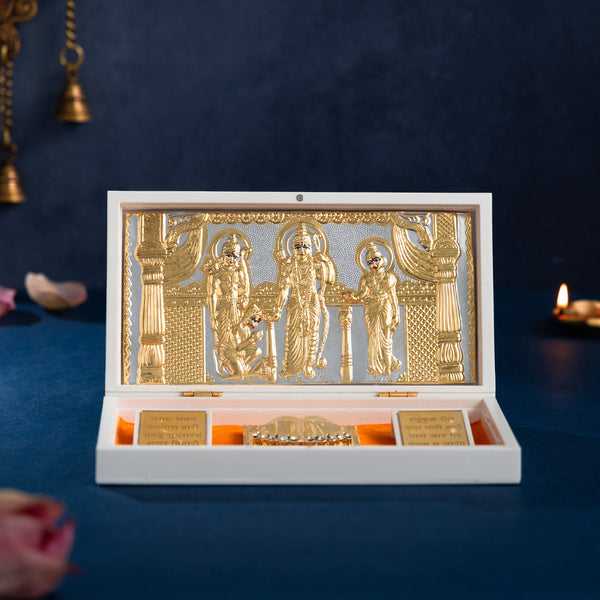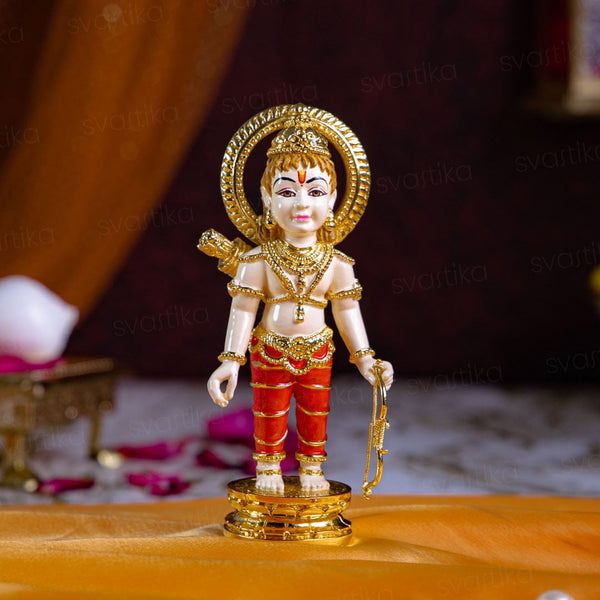The story of Lord Ram is one that has been passed down from generation to generation.
Hailed as one of the epic tales ever written, Ramayana follows the story of Lord Ram. And right at the beginning of his majestic story is his father, Dasharatha, King of Ayodhya.
Dasratha was married to Kaushalya, Sumitra, and Kaikeyi. Despite this, he had no sons. When King Dasaratha was childless, he sacrificed a horse (an Asvamedha) in the hopes that the gods would grant him a child.
Several gods conspired to persuade Lord Vishnu to assume the form of King Dasaratha's sons in order to vanquish the demon Ravana. The enchanted offering was divided among his three wives.
King Dasaratha was told to split the portion between his wives, so he honored Kausalya's seniority by giving her half and showing his affection for Kaikeyi by giving her the other half. As there was nothing left for Sumitra, Kausalya, and Kaikeyi split their servings in half and gave them to her.
Sumitra had twins because she was double-served and so became pregnant twice. Kaikeyi gave birth to Bharata, while Sumitra had Laksmana and Shatrughna. Lord Ram was born to Kaushalya.
Thus, he had four sons after he performed the Putrakameshti yagna to conceive. When his sons reached adulthood, he decided to retire and make his eldest, Rama, the prince.
Children of Dasharatha
1. Rama

Rama (or Ramacandra) is the seventh incarnation (avatar) of Vishnu in Hinduism.
Both the oldest Sanskrit epic, the Ramayana, written about the 5th century BCE with some later revisions, and the Vana Parva of the Mahabharata commemorate his exploits, including the defeat of the demon king Ravana.
Many Hindus believe that the mythical Lord Rama was inspired by a real person from Hindu history. Lord Rama and his wife Sita are often regarded as Hindu mythology's most virtuous couple.
Maryada Purushottama is the ideal guy, and that is what Ramachandra is. It is believed that Lord Rama came to Earth to vanquish the evil powers of his time.
We defeated the demonic ruler of Lanka, Ravana, and rescued his kidnapped wife, Sita. Lava and Kusha, his sons, were born to him. And his grace and power still live on to this day, his story forever etched into the walls of our history!

Svastika Ram Darbar Pocket Temple - Gold Plated

Childhood Form of Lord Ram - Gold Plated (6 Inch)
2. Shanta

Shanta was the sister of Lord Rama and the daughter of Raja Dasharatha.
Once, King Dasharatha learned that Raja Rajarompada had no children when he travelled to Ayodhya with his wife to see King Dasharatha, King Dasharatha, feeling the couple's anguish over their inability to start a family, handed them his eldest daughter, Shanta.
Shanta was crowned the princess of Anga. She had an extensive background in Vedic knowledge, art, craft, and combat. She wed Rishyasringa, who also conducted the putra kameshthi yajna that resulted in Dasharatha's four sons—Rama, Bharata, and the identical twins Lakshmana and Shatrughna—being born to him.
Shringa Rishi is a temple dedicated to Devi Shanta, the older sister of Lord Rama. The temple can be found at Kullu, Himachal Pradesh. Shanta, the goddess, and her husband, the sage Shring Rishi, are both honored at this temple.
3. Bharat

Bharata is a well-known name from the Ramayana, an ancient Indian epic. He was born to Kosala King Dasharatha and Ashvapati of Kekeya's daughter, Kaikeyi.
This individual is Rama's younger half-brother. While Rama is exiled, he acts as the regent of Ayodhya and leads the fight to free Rama's abducted wife, Sita.
Mandavi, the daughter of Kushadhwaja and Chandrabhaga, was married to Bharat. Kushadhwaja was the brother of King Janaka of Mithila, making Mandavi a cousin of Sita. Taksha and Pushkala are his two sons.
Bharata is described in the Ramayan as an embodiment of dharma. Bharata was Rama's younger brother and an idealist and defender of dharma. While Rama was an incarnation of Vishnu, other myths hold that Bharata was an avatar of Vishnu's Sudarshana Chakra.
In Nandigrama, Bharata encountered Hanuman, who filled him in on all that had happened during Rama's exile.
Bharata returned Rama's shoes to him when he saw him again, holding them high above his head like a trophy. Bharata and Kaikeyi made up when Rama was crowned king of Kosala.
Present-day Bharata worship is concentrated in Kerala.
4. Lakshmana

Lakshmana and Shatrughna, the twins, were born to Sumitra. Lakshman, sometimes called Lakhan or Soumitra, was Lord Rama's trusted friend and ally.
Lakshmana wed Sita's younger sister Urmila. Angad and Chandraketu, two sons, were born to them.
During the exile, he also served Rama and Sita with great respect. According to the Puranas, Lakshmana is a representation of Shesha, the multi-headed naga (serpent) upon which Vishnu, whose avatar Rama is believed to be, rests for preservation.
If Rama represents Vishnu and Bharat represents the Sudarshana Chakra, then Lakshman represents Shesha or Sheshnaag, the 1000-headed serpent, which is the age-old belief.
Lakshmana travelled to Mithila with Rama and the teacher Vishvamitra when Rama was asked to kill demons in the forest. The bond between Rama and Lakshmana was extremely strong.
Lakshmana followed Rama and Sita into exile when the latter was banished for fourteen years at Kaikeyi's urging.
In their subsequent incarnations, Rama and Lakshmana are claimed to have taken the names Krishna and Balarama.
A story of siblings greatly revered across times, the bond between Lord Ram and Lord Lakshman is one never to be forgotten.
5. Shatrughna

In the Hindu epic Ramayana, Shatrughna is a prince of Ayodhya and the king of Madhupura and Vidisha. He is also the youngest brother of Prince Rama. Ripudaman is another name for him (vanquisher of foes).
His brother Lakshmana is his twin. Like Lakshmana was faithful to Rama, so is he to Bharata. Shatrughna is the reincarnation of the Sudarshana Chakra, as described in the Valmiki Ramayana.
The 412th name of Vishnu in the Mahabharata's Vishnu Sahasranama is Shatrughna. He was responsible for the death of Lavanasura, the demon king of Mathura and Ravana's nephew. He wed King Kusadhvaja's third daughter, Princess Shrutakirti.
Sheshanaga, Panchajanya, and the Sudarshana Chakra are portrayed in the Ramayana as avatars of Lakshmana, Shatrughna, and Bharata, while Rama himself is the seventh incarnation of Vishnu.
Although Bharata was supposed to rule Ayodhya in Rama's absence, it was actually Shatrughna who took on the responsibility of running the entire kingdom in the stead.
During Rama, Lakshmana, and Bharata's exile from Ayodhya, the only comfort for the three queen mothers was Shatrughna.
Conclusion
The complicated family tree portrayed in Ramayana paved the way for the making of this epic story.
Tales of bravery, love, betrayal, and grief are intricately woven amongst this powerful family who stands united and divided in their own rights.
The four brothers, despite the various deceits they were subjected to, stood strong, relying upon one another to bear through the difficulties they came across. Each brother has unique and commendable qualities that make their character dear to us.







